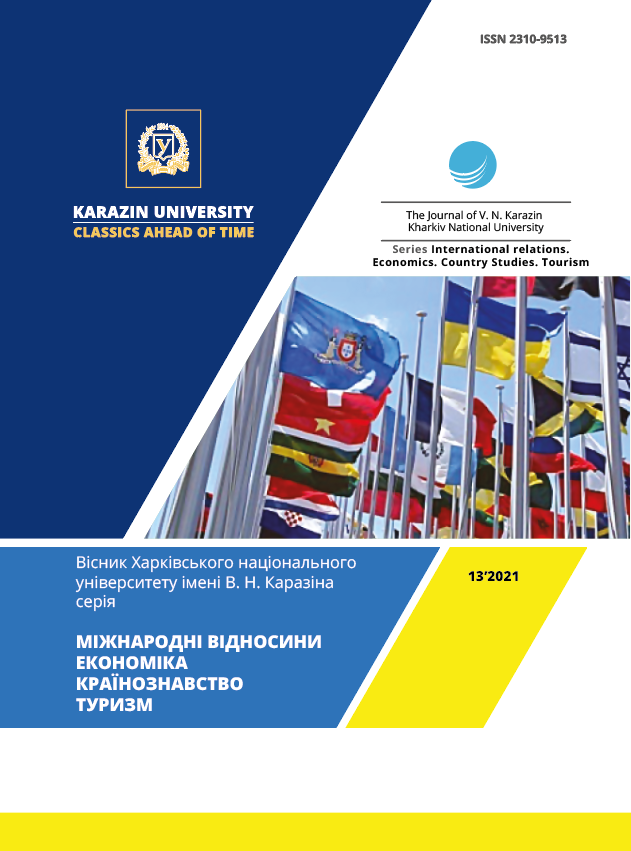Global food security: trends and challenges
Abstract
Food is the primary need of any human being, which is why the food security at the both national and global levels is always important. The subject of this research is the global food security. The purpose of this article is to analyze the current state of global food security, identify its main challenges and development trends of recent years. To achieve the goal of this article the author sets and solves following tasks, namely, analyzes different approaches to defining the concept of «food security» and the number of starving people in the world and in its regions for the period 2005-2021, identifies the main challenges for the world food security. General scientific methods were used to achieve the goal of research: analysis, synthesis, systematization, comparison, abstract-logical method. The results of the research show that number of starving people both quantitatively and in percentage terms from 2005 to 2018 almost constantly decreased, and from 2019 began to grow steadily. The author notes that the largest number of starving people live in Asia, and the largest percentage of the undernourished population live in the African region. Since 2020 global food security has worsened significantly, and the main reason for this was the global COVID-19 pandemic, because of which the starving people number began to rise rapidly across the planet. The main negative impact was manifested in the population income decrease and an food prices increase. In addition, the negative consequences of the COVID-19 pandemic were also manifested in the reduction of food production, namely, the access of small producers to the necessary resources was reduced, some food products demand decreased due to the closure of public catering establishments, and also there was a temporary suspension of exports. The author highlightes that at the beginning of 2022 a new global food security challenge appeared, it was the Russian-Ukrainian war. Due to the stopping of Ukrainian exports, record food prices were observed, which significantly worsened the access of the low-income population to food products. After the signing of the grain agreement and the resumption of Ukrainian grain exports, the situation stabilized. Conclusion: a steady deterioration of global food security has been observed since the beginning of 2020, the main cause of which was the COVID-19 pandemic, and in 2022 appeared a new challenge, Russian-Ukrainian war.
Downloads
References
/References
FAO, IFAD, UNICEF, WFP and WHO. The State of Food Security and Nutrition in the World 2022. Repurposing food and agricultural policies to make healthy diets more affordable. Rome, FAO. 232 р.
Закон України «Про продовольчу безпеку України». URL: http://w1.c1.rada.gov.ua/pls/zweb2/webproc4_2?pf3516=8370-1&skl=7.
Саблук П. Т., Білоус О. Г., Власов В. І. Продовольча безпека України. Економіка АПК. 2009. № 10. С. 3-7.
Румик І.І. Продовольча безпека в умовах компліментарності національної економіки : дис. ... док. екон. наук : 08.00.03 / Університет економіки та права «Крок». Київ, 2020. 567 с.
Вопросы и ответы: пандемия COVID-19 – последствия для агропродовольственного сектора. URL: https://www.fao.org/2019-ncov/q-and-a/impact-on-food-and-agriculture/ru/
FAO, IFAD, UNICEF, WFP and WHO. The State of Food Security and Nutrition in the World 2021. Transforming food systems for food security, improved nutrition and affordable healthy diets for all. Rome, FAO. 2021. 240 р.
World food situation. URL: https://www.fao.org/worldfoodsituation/foodpricesindex/en/
Кучечук Л.В. Вплив пандемії Сovid-19 на загострення глобальної продовольчої проблеми. Матеріали Всеукраїнської наукової конференції «Особливості суспільно-політичного розвитку та модернізаційні процеси у країнах пострадянського простору». Харків : ХНУ імені В. Н. Каразіна 2022. С. 79-82.
Глобальна продовольча криза через рф. URL: https://www.ukrinform.ua/rubric-economy/3544229-globalna-prodovolca-kriza-cerez-rf-ukraina-zapuskae-komunikacijnu-kampaniu.html
Виклики для продовольчої безпеки: що пропонує СОТ. URL: https://www.eurointegration.com.ua/experts/2022/10/17/7148819/
FAO, IFAD, UNICEF, WFP and WHO (2022). The State of Food Security and Nutrition in the World 2022. Repurposing food and agricultural policies to make healthy diets more affordable. Rome, FAO. 232 р.
Zakon Ukrainy «Pro prodovolchu bezpeku Ukrainy». Available at: http://w1.c1.rada.gov.ua/pls/zweb2/webproc4_2?pf3516=8370-1&skl=7.
Sabluk P. T., Bilous O. H., Vlasov V. I. (2009) Prodovolcha bezpeka Ukrainy [The food security of Ukraine] Ekonomika APK. Vol. 10. pp. 3-7.
Rumyk I.I. (2020) Prodovolcha bezpeka v umovakh komplimentarnosti natsionalnoi ekonomiky [The food security in the context of the complimentary of the national economy] (PhD thesis), Kyiv: University of economics ana law «Krok».
Voprosu y otvetu: pandemyia COVID-19 – posledstvyia dlia ahroprodovolstvennoho sektora. Available at: https://www.fao.org/2019-ncov/q-and-a/impact-on-food-and-agriculture/ru/
FAO, IFAD, UNICEF, WFP and WHO (2021). The State of Food Security and Nutrition in the World 2021. Transforming food systems for food security, improved nutrition and affordable healthy diets for all. Rome, FAO. 240 р.
World food situation. Available at: https://www.fao.org/worldfoodsituation/foodpricesindex/en/
Kuchechuk L.V. (2022) Vplyv pandemii Sovid-19 na zahostrennia hlobalnoi prodovolchoi problemy [The impact of COVID-19 pandemic on the food problem aggravation] Proceedings of Vseukrainskaya naukova konferentsia «Osoblyvosti suspilno-politychnoho rozvytku ta modernizatsiini protsesy u krainakh postradianskoho prostoru». Kharkiv : KhNU imeni V. N. Karazina pp. 79-82.
Hlobalna prodovolcha kryza cherez rf. Available at: https://www.ukrinform.ua/rubric-economy/3544229-globalna-prodovolca-kriza-cerez-rf-ukraina-zapuskae-komunikacijnu-kampaniu.html
Vyklyky dlia prodovolchoi bezpeky: shcho proponuie SOT. Available at: https://www.eurointegration.com.ua/experts/2022/10/17/7148819/
Authors who publish with this journal agree to the following terms:
- Authors retain copyright and grant the journal right of first publication of this work under the terms of a license Creative Commons Attribution License 4.0 International (CC BY 4.0).
- Authors are able to enter into separate, additional contractual arrangements for the non-exclusive distribution of the journal's published version of the work (e.g., post it to an institutional repository or publish it in a book), with an acknowledgement of its initial publication in this journal.
- Authors are permitted and encouraged to post their work online (e.g., in institutional repositories or on their website) prior to and during the submission process, as it can lead to productive exchanges, as well as earlier and greater citation of published work.




